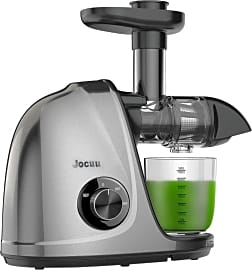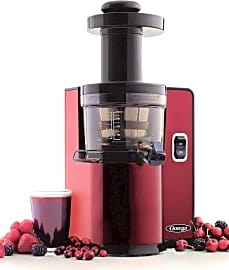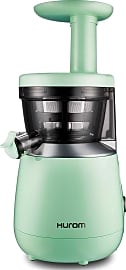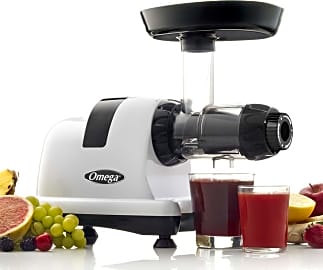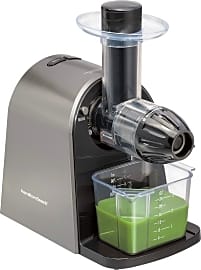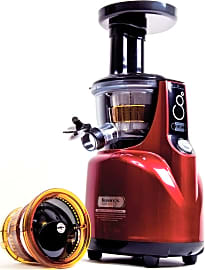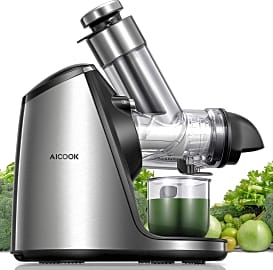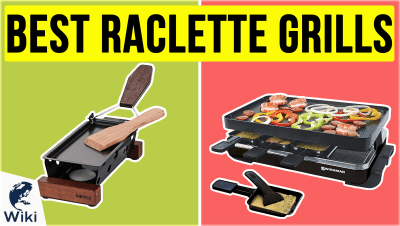The 10 Best Masticating Juicers

This wiki has been updated 46 times since it was first published in April of 2015. Sometimes the best things in life take a bit longer to make. These slow masticating juicers promise to turn fruits and vegetables into delicious drinks while retaining all the flavor, vitamins, and nutrients by minimizing heat buildup and oxidation. You'll get more out of the produce you put in, and you can taste the difference. Many help you with other foods, too, such as nut butter or soy milk. When users buy our independently chosen editorial selections, we may earn commissions to help fund the Wiki.
Editor's Notes
December 16, 2020:
As compared to centrifugal juicers, masticating machines operate more slowly. The result is less heat, which translates to less oxidation of the vitamins and nutrients in your foods, so you get a healthier beverage.
During our research, we noted that there don't seem to be a lot of advancements year to year in masticating juicers. Because of that, this update was all about eliminating discontinued models or those that haven't proven themselves to continue operating reliably over time.
Falling into this first category, we have the Mueller Austria Ultra. Since we can no longer find it on the manufacturer's website, nor is it available in most stores, we have to assume it has been discontinued and is no longer on the market. The same can be said for the Breville Fountain Crush. While we are disappointed, as these were quality machines, we have found a suitable replacement. Taking the spot of both of these models is the Breville Big Squeeze, which is also a vertical option that doesn't require too much counter space. It features a 240-watt motor, which is more powerful than that on the Ultra and equal to that of the Fountain Crush, and a three-inch feed chute, which is equal to that of the Ultra and larger than that of the Fountain Crush. So, basically, it encompasses the best features of both of these without the drawbacks of either.
In the latter category of machines that just didn't stand the test of time, we eliminated the Kuvings Multi-Purpose because there were simply too many reports of the some of the plastic components cracking over time. While we have still kept the Kuvings Silent SC Series on the list since it doesn't seem to suffer from this same issue, we will be keeping a close eye on it and update our readers if anything changes. Since the Kuvings Multi-Purpose was a very compact machine, we replaced it with an equally small model, the Jocuu 217, which also has the bonus of being more budget friendly than the Kuvings. Two other somewhat diminutive options that were added during this update were the Hamilton Beach 67951 and Aicook SJ-Z1, however each of these has a drawback that makes us recommend the Jocuu first. In regards to the Hamilton Beach, it's that it seems to struggle on some hard foods, and in the case of the Aicook, it is the fact that the chute is smaller than advertised, which we consider to be deceptive marketing and have hard time condoning, even if it isn't any smaller than the one on the Jocuu.
November 19, 2019:
Anyone with even passing familiarity with juicers won't be surprised to see some of the names on this list, including Kuvings, Hurom, and Breville. These masticating options offer good results with cleanup that isn't too burdensome. The exception to this is the Kuvings Silent SC Series, simply because it can be a bit of a pain to disassemble. You'll also find two options from popular maker Omega. These are the Omega J8006HDS Nutrition Center and the Omega VSJ843Q. The former is known for an occasional issue where the screen can crack, but it's possible to replace this, so there's no need to junk the whole machine. We removed the very similar Omega NC900HDC because it also suffers from this screen problem and is less powerful than the J8006HDS.
We've also opted to remove a couple of lesser-known choices because of both long-term quality and availability issues, including the Aicok Cold Press. In their place, you'll find the top-notch Tribest Greenstar Elite, which is admittedly pricey, and the Mueller Austria Ultra, a budget-friendly option. It is a good starting point for those moving from a centrifugal juicer to a slow, masticating version.
Special Honors
Goodnature X1 The Goodnature X1 is a serious commercial cold press machine that offers businesses the ability to produce up to 1,000 bottles a day. It's made in the USA with high quality components and conforms to a range of industry standards for your safety and peace of mind. goodnature.com
Sana Horeca EUJ-909 The Sana Horeca EUJ-909 offers commercial-grade quality for juice bars, health clubs, and more. A relatively quiet choice, it won't bother customers while in operation, and the smooth, foam-free product should please even the pickiest of palates. sana-store.com
Chew Or False: Mastication Is The Way
Enter the masticating juicer, with its ribbed auger and simple but effective pulp ejection system.
Chew. Or true, regarding that mastication question.
Mastication, it turns out, means chewing! Each and every one of us is actually born equipped with our very own masticating juicer: the mouth. A twofold problem arises here, though.
First off, our mouths are particularly bad at separating the juice from the pulp, despite their excellent masticating abilities.
The other fold of the problem is that we have a tendency to work our food over like an industrial vacuum cleaner, allowing nowhere near enough time to truly extract the nutrient potential of our fruits and vegetables. And if you did put forth that much effort in chewing, well, your jaw would be in shambles.
Enter the masticating juicer, with its ribbed auger and simple but effective pulp ejection system. This shape and design creates an environment in which food material gets chewed up and pushed outward toward the front of the juicer while the juice falls down toward a catch basin of your choosing. Or your...chewsing. Huh?
Other designs you'll see combine a vertical auger system with a built in catch basket, which is more convenient at the outset, but does make the unit a little harder to clean once you're done juicing.
Whether Tis Nobler To Juice Or To Blend
Juicing and blending get compared to each other a lot. There are countless videos online, nutrition blogs, and forums all dedicated to the comparison between and among juicers and to the benefits of juicing over blending, a lot more videos, blogs, and forums, in fact, than there are scientific studies comparing the methods.
Still, if you take a little time to think about the basic truths and common sense knowledge revolving around food, you can get a good idea of what each method offers the consumer.
Blenders and centrifugal juicers whip more oxygen into their juices and mixes.
The one thing we need to talk about is enemy numero uno: Oxygen. Sure, we need it to breathe and all, but it has the unique ability to diminish the nutrient content of your fruits and vegetables.
Here's a thought experiment: What happens to an apple when you cut it in half and leave it out on the counter? It starts to turn brown on the inside, right? This is called oxidation, and it kills a lot of the live enzymes you want to consume to maximize your health.
That doesn't mean than an oxidized apple is bad for you in any way. It's just not as good for you as a perfectly fresh apple.
Now, if you don't cut that apple at all, but you leave it on the counter for, say, two months, it'll still shrivel up and die, just a lot more slowly. It's a process that's constantly going on, you see, so you can never get at 100% of the available nutrients of anything. They're in a constant state of flux. Again, this is about maximization.
Blenders and centrifugal juicers whip more oxygen into their juices and mixes. It's that simple. So, for the maximum enzyme content and, arguably, the highest nutrient count, you're going to want a masticating juicer. Or you're going to want to start exercising those jaw muscles like crazy.
Juicing Through Time
As we mentioned earlier, mastication has been around since the the first identifiable chewing mechanisms were evolved among species. So, in that sense, we've been juicing for a while.
Early juicers were press-based, using direct force to crush the food in a machine rather like a vice, which was messy at first, but refined over the years.
But as far as any record of human beings using their heightened capacity for tool development to separate the liquid elements of their food from the solid, well, that has to go back to the invention of wine. After all, you can't have wine without grape juice, and wine goes back at least to 7000 BCE.
There's even a history of mastication with the human mouth, like in Brazil, where Cauim is traditionally brewed only after its roots have been chewed and spit out by the women of a tribe.
The kind of juicing we're focused on here had its birth at the turn of the 20th century, when dietary sciences first began to promote vegetable juices as part of a substantially healthier human diet.
Early juicers were press-based, using direct force to crush the food in a machine rather like a vice, which was messy at first, but refined over the years.
Later texts in the field lead to the development of the Norwalk juicer, the Champion juicer, and other early brands in the 50s and 60s.
Nowadays, there's no shortage of brands and styles for your juicing preference, but cold-pressed mastication is the highest combination of the healthiest techniques and most powerful technology.


